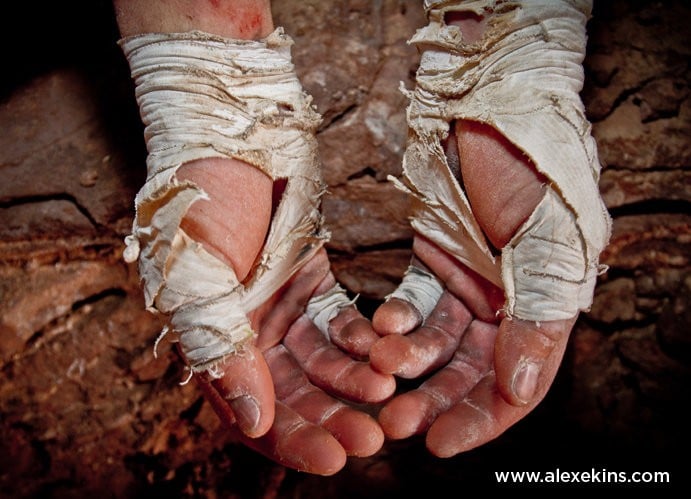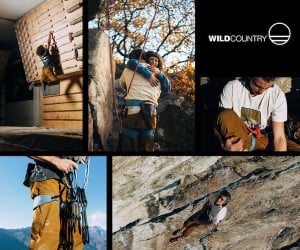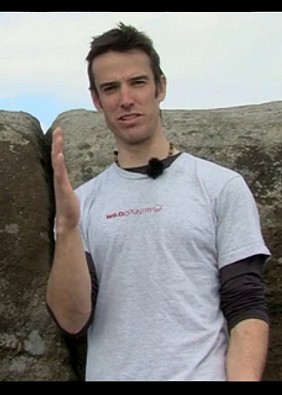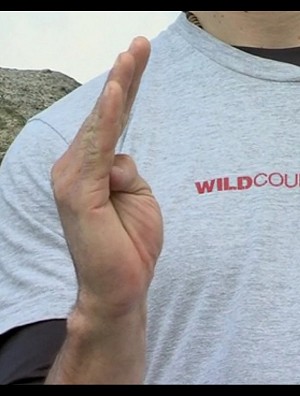Part 2 - Jamming
Hand Jamming
The hand-jam is the most fundamental of all the jamming techniques. Partly as it is the type of jam that you will use the most when learning, but mainly because the principles of it are played out on many of the other crack sizes. For this reason, it is well worth spending a decent amount of time becoming proficient at this technique.
Fortunately the grade of many hand cracks out there is not too desperately high, so it is certainly possible to learn this method of jamming whilst on routes that are within your grade. It may not feel this way to start with, but I promise you will get there with perseverance! When I first learnt to hand jam, I went from leading E3 to utterly failing on HVS, so it'll all about sticking in there.
Once you master the basic hand jam, you will find that a secure hand jam, in fact, becomes better than a jug. On many routes, you'll also come across sneaky rests that can be obtained by using this technique – especially in breaks and between tufas on sport routes.
Techniques and tips
There are two crucial aspects to a good hand jam. One is the position of the thumb, and the other is the orientation of your hand in the crack. As you'll see in the video, the thumb acts as an amazing active spacer in the crack, which means you can expand the width of your hand. You will find that if you don't use your thumb effectively (you should be trying to push the tip of it towards the base of your pinky) the jamming process feels very strenuous. The key to using your thumb action is to push it hard towards your pinky before fully weighting your hand jam – that way you produce maximum width, before putting all the force through it.
Secondly, you'll notice (along with many other crack techniques) that you can orientate your hand in the crack with the thumb pointing towards the sky ("thumbs-up"), or to the ground ("thumbs-down"). Both positions have very different "feels" to them, so it's worth practicing both in equal portions. There's no steadfast rule about which position you should use in any given situation, so spend lots of time experimenting. There is one thing worth noting – if you're looking to make an extra long reach from a hand jam, then you will almost certainly want to use a thumbs-up jam.
The one thing that most people question me about when learning to hand jam is "why is it so painful?" The answer is partly because the backs of our hands are very sensitive, but also because to start with you will be slipping in your jams, causing friction burns or cuts. The good news is that with practice, your skin becomes accustomed to the pain and with very regular use, even forms tougher skin. I'm not expecting most people to become overnight jamming obsessives, so the real answer is to tape up and protect your hands – see the protection video episode!
Feet
Like almost all types of climbing, the feet are important to success in hand cracks. This is because the foot jams that you'll find are so secure, you will be able to take plenty of weight off your arms and hopefully get a bit of a rest, or even place some gear.
When placing your foot in a hand-sized crack, turn your foot so that your knee points outwards from the crack and your foot is able to fit inside with the tops of your shoes touching the crack on one side and the sole of your boot on the other. Very similar to your hands, try to push the foot in quite deeply and so that it feels really snug before you even contemplate weighting it. The final movement in this process is to then twist your knee so that it becomes more parallel to the crack and in turn your foot will be twisted very securely into the crack. It's worth noting, that this will feel pretty painful when you first try it, so don't think you're doing anything wrong if it hurts! I've always found that have a nice comfortable pair of (non-downturn) boots really helps with the pain.
Types of hand crack
One of the best things about hand cracks is that they can be hugely varied in type, but still remain at reasonable grade – you only have to look at Roof Route at Rivelin; an HVS roof crack! Whatever the angle of hand crack that you find yourself on, the jams and orientation of your hands will be fairly similar. What does change the "rules of engagement" though, is how overlapping the edges of the crack are or whether the crack lies in a corner. If either of these is the case, you'll notice that it's almost impossible to cross hand-over-hand up the crack, because the edges of the crack get in the way of your wrists. To get around this, it's best to use the "swimming-technique" that Pete uses in the video, where one hand stays on the bottom in a "thumbs-up" position and the other leads in a "thumbs-down" position.
Classic Hand cracks / routes with crucial hand crack sections
If you use the UKC logbook system you can subscribe to the ticklist here.



